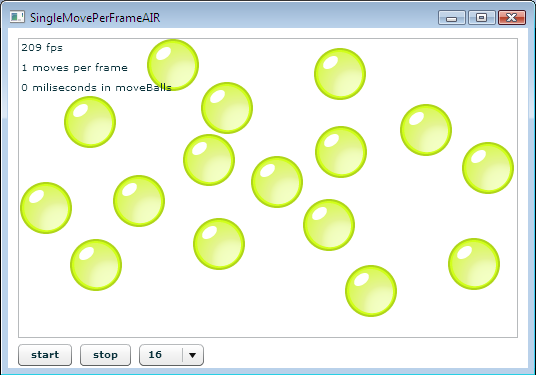Bursting Bubbles
 Bubblemark is a popular benchmark for some of the RIA technologies including Flex, Adobe AIR, Ajax (DHTML), Java Swing, Java FX, Silverlight, etc. I’ve been trying for a while to create a new Flex version of Bubblemark to show just how fast Flash Player and Adobe AIR are. But I’ve come to a few realizations… First, you can make benchmarks say whatever you want them to say.
Bubblemark is a popular benchmark for some of the RIA technologies including Flex, Adobe AIR, Ajax (DHTML), Java Swing, Java FX, Silverlight, etc. I’ve been trying for a while to create a new Flex version of Bubblemark to show just how fast Flash Player and Adobe AIR are. But I’ve come to a few realizations… First, you can make benchmarks say whatever you want them to say.
When trying to optimize Bubblemark I found a few interesting things. First was that IE (and some versions of Firefox) limit the frame rate of Flash Player (and possibly other plugins). This means that while the Flash Player VM might be able to actually achieve 200+ frames per second the actual visual result might be only 60 fps. And maybe this is for good reason. Why do you need a visual frame rate faster than the refresh rate on a monitor? You don’t. And especially not for RIAs.
Graphic rendering performance is certainly relevant for RIAs but that is only one factor which affects overall application performance. As Chet Haase points out, Bubblemark lumps a number of different factors - calculation speed, rendering performance, and timer resolution - into a single “frames per second” metric. That leads to my second realization.
The frame rate of bouncing bubbles isn’t very relevant to RIAs. As Josh Marinacci of Sun says - “there aren’t any real benchmarks yet for rich internet applications.” I think that my Census RIA benchmark is more pertinent to RIAs than bouncing bubbles. Census benchmarks how quickly an application can get data from a server, parse that data, and render the data in a datagrid. Sorting and filtering are also important benchmarks that I’m working on integrating into Census. Today the Census app has various Flex and Ajax tests but I’m also currently working on adding a Silverlight test, an Ext JS test, and an updated Dojo test. I’d love it if someone would create a Java FX version as well.
Just for kicks let’s go back to Bubblemark and see what I was able to come up with (with help from Chet Haase). I created two versions of the new Flex Bubblemark application. You can run each version in the browser (Flash Player) or on the desktop (Adobe AIR). The results will vary between the web and desktop versions due to the browser throttling. The first application will only move the bubbles once per frame. This is similar to the original Flex Bubblemark application. If the browser is only letting Flash Player run at 60 fps then the maximum fps will be 60. Adobe AIR seems to limit the fps to 250 but I haven’t yet confirmed that. With both of these versions CPU utilization should be pretty low since they are being artificially throttled. The second set of applications moves the bubbles as many times as possible per frame. The appearance of these might be choppy since the bubbles only get rendered after being moved potentially hundreds of times. The second set of benchmarks is more real world if you are interested in VM processing speed as opposed to resolution of the timing mechanism. However a third set of tests which is probably the most useful and that I haven’t yet written would calculate how many bubbles can be moved once per frame and maintain 60 fps. That kind of metric is probably relevant to RIAs that need to do a lot on every frame. But most RIAs I’ve seen are more concerned with the speed of data processing. Here are the new Flex Bubblemark applications:
Single Move Per Frame: Web | Desktop (requires Adobe AIR 1.0)
Many Moves Per Frame: Web | Desktop (requires Adobe AIR 1.0)
Benchmarks are only useful when you apply them to your scenario. Is the performance good enough for what you need? Are your users able to run what you build? There are thousands of RIAs which run in Flash Player and now hundreds of Adobe AIR applications. For the millions of users of these applications the frame rate is fast enough and the VM performance is superb. For the developers of these applications the Flex tooling enabled them to efficiently build these applications. Not only do the runtimes and the tools work on Windows, Mac, and Linux - the runtimes and core development tools are free. There is more to choosing a platform than the speed at which a runtime can bounce objects around the screen. Sorry if I’ve burst any bubbles.